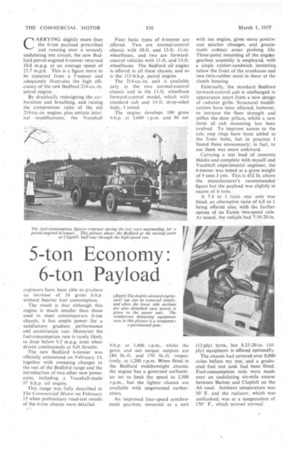5-ton Economy: 6-ton Payload
Page 46

Page 47

If you've noticed an error in this article please click here to report it so we can fix it.
engineers have been able to produce an increase of 16 gross b.h.p. without heavier fuel consumption. , The result is that although this engine is much smaller than those used in most contemporary 6-ton chassis, it has ample power for a satisfactory gradient performance and acceleration rate. Moreover the fuel-consumption rate is rarely likely to drop below 9.5 m.p.g. even when driven continuously at full throttle.
The new Bedford 6-tanner was officially announced on February 14, together with sweeping changes to the rest of the Bedford range and the introduction of two other new power units, including a Vauxhall-made 17 b.h.p. oil engine.
This range was fully described in The Commercial Motor on February 15 when preliminary road-test results of the 6-ton chassis were detailed.
r b.h.p. at 3,400 r.p.m., whilst the gross and net torque outputs are 184 lb.-ft. and 170 lb.-ft. respec tively, at 1,200 r.p.m. When fitted in the Bedford middleweight chassis, the engine has a governed carburetter set to limit the speed to 3,500 r.p.m., but the lighter chassis are available with ungoverned carburetters.
An improved four-speed synchromesh gearbox, mounted as a unit (12-ply) tyres, but 8.25-20-in. (10ply) equipment is offered optionally.
The chassis had covered over 8,0130 miles before my test, and a graduated fuel test tank had been fitted. Fuel-consumption tests were made over an undulating six-mile course between Barton and Clophill on the A6 road. Ambient temperature was 50° F. and the radiator, which was unblanked, was at a temperature of 1700 F.. which Droved normal.
For my first test 1 drove the 6-tonner gently, restricting the speed to 30 m.p.h., although using full throttle on hills to try to maintain this speed. The circuit was completed at an average speed of 25.7 m.p.h. and the fuel-consumption rate was 10.8 m.p.%.
A second run was then made using full throttle almost continuously, and whenever the road and traffic conditions permitted, the vehicle was taken up to 40 m.p.h. This treatment did not increase the fuel consumption as much as I had feared, the final figure being 9.7 m.p.g. at an • average speed of 30.5 m.p.h. The time-load-mileage factors of 2,539 and 2,708 which resulted from these tests show remarkable economy for a petrol-engined 6-toriner. The vehicle will particularly appeal to operators who, for various reasons, have no choice but to operate petrol chassis and accordingly have to meet heavy fuel bills.
• Acceleration tests were conducted next, a level stretch of the A6 road between Luton and Harpenden being chosen. During the standing-start tests up to 30 m.p.h., first, second and third ratios were used, and the average time of 29.1 seconds taken to reach 30 m.p.h. is again above 'average for a 6-tonner. Maximum speed in top gear is 49 m.p.h.
The relatively low torque output was felt during the direct-drive tests. however, and it took 50 seconds to reach 30 m.p.h. from 10 m.p.h. The gearbox is there to use however, and ,there is no point in taking the risk of overstressing the engine by making it pull hard in high gear.
Widely spaced ratios are employed in the gearbox, first gear being particularly low, but this wide range helps to give a satisfactory overall performance under varied conditions. Whilst it is possible to start in second gear, this is not advisable during normal use and first gear should always be used except when starting on a down grade.
There was no transmission roughness when pulling away in top gear from 8 m.p.h.; but slight pinking was noticeable up to 11 m.p.h. at full throttle.
Braking testsserved to highlight the well-known efficiency of Bedford brakes once more, and the figures' obtained would be good for a vehicle running a ton lighter. There was negligible delay in the system, for there was only about 6 per cent: difference between the maximum and average deceleration rates obtained from each speed.
When using the hand brake to stop the vehicle from 20 m.p.h., 38 per cent. efficiency was obtained on repeated occasions, although. the drums were still warm from the footbrake tests.












































































































